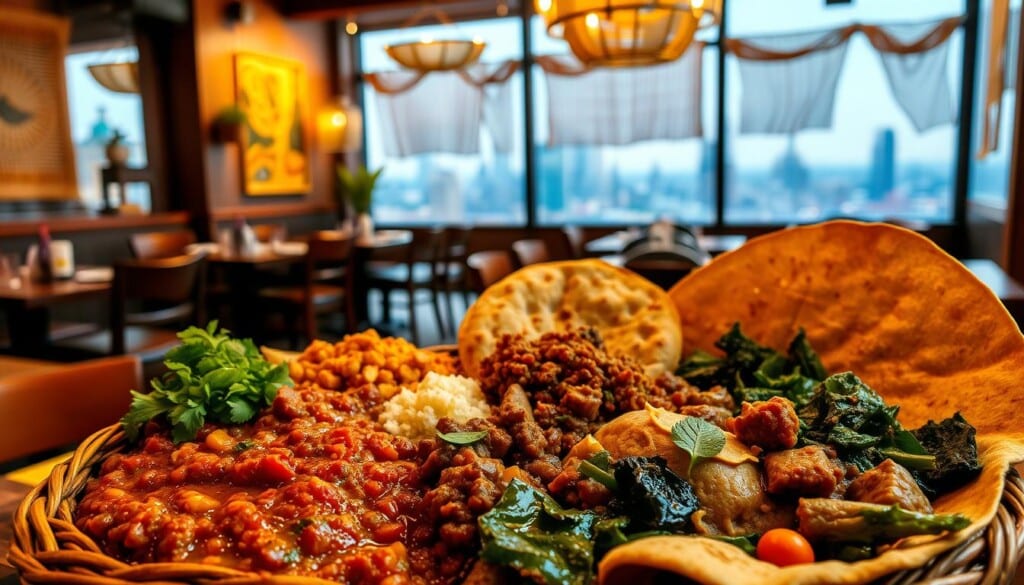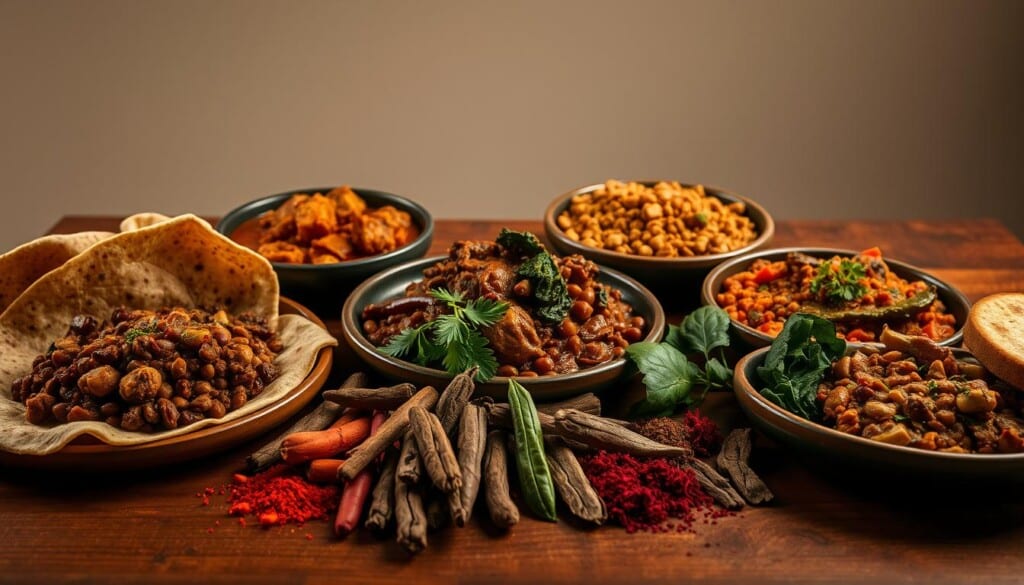Have you ever wondered why Ethiopian food is so loved in America? Despite a small Ethiopian population, over 300,000 immigrants have brought their flavors to the USA. Ethiopian Food Restaurants are now a top choice for food lovers across the country.
These restaurants are known for their unique spices and the way everyone shares food. Enjoying meals with traditional injera makes the experience even better. This article will show you the best places to try Ethiopian food.
Key Takeaways
- Ethiopian cuisine features communal dining with a focus on shared dishes.
- Injera plays a critical role in enjoying authentic Ethiopian meals.
- Over 300,000 Ethiopian immigrants contribute to the rising popularity of Ethiopian food.
- Exploring Ethiopian food offers a unique mix of spices and flavors.
- Restaurants in big cities are cultural hubs for Ethiopian food traditions.
Exploring the Rich Flavors of Ethiopian Cuisine
Ethiopian cuisine is known for its bold flavors and colorful presentation. It has gained fame worldwide. Traditional Ethiopian dishes offer many vegetarian options, perfect for health-conscious eaters. They are rich in legumes, vegetables, and spices, providing health benefits.
These dishes are a great choice for any Ethiopian food menu.
The Health Benefits of Traditional Ethiopian Dishes
Traditional Ethiopian dishes are full of nutrients, benefiting many people. Lentils and chickpeas add flavor and provide protein and fiber. This makes them a great choice for those looking to eat healthy.
Unique Ingredients in Ethiopian Cooking
Ethiopian cooking uses special ingredients. Berbere spice gives a unique heat, while kibe adds a rich flavor. Regional vegetables add to the dish’s complexity.
This mix of ingredients defines Ethiopian cuisine.
Importance of Injera in Ethiopian Meals
Injera is key in Ethiopian meals, serving as both food and utensil. It’s a sourdough flatbread that acts as a base for many dishes. It also makes communal dining possible, a big part of Ethiopian culture.
Top Ethiopian Food Restaurants Across Major Cities
Exploring the best Ethiopian food in major U.S. cities is exciting. You’ll find authentic flavors and modern twists. These spots are great for those looking for Ethiopian restaurants near them, making dining out a treat for everyone.
New York City: A Melting Pot of Flavors
In New York City, Enat Ethiopian Restaurant is a must-visit. It offers traditional dishes at affordable prices. People love the authentic taste and the injera, a key part of every meal.
This place draws both new and regular Ethiopian food fans. They come for the unique flavors.
Washington, D.C.: A Hub for Authentic Ethiopian Eats
Letena in Washington, D.C. brings a fresh take to Ethiopian food. It focuses on healthy vegetarian dishes. The lively atmosphere and fresh ingredients make it a hit.
Many rave about the chefs’ creativity. Dining here is memorable, thanks to great service and delicious food.
Los Angeles: A Diverse Ethiopian Dining Scene
In Los Angeles, Radio Africa & Kitchen stands out. It’s all about sustainability in Ethiopian dining. The restaurant offers creative takes on classic dishes.
It’s a favorite for those eager to try authentic Ethiopian food. The quality and flavors are top-notch, making it a go-to spot for many.

How to Enjoy an Authentic Ethiopian Dining Experience
For those eager to dive into Ethiopian cuisine, knowing the dining customs is key. Meals are eaten with injera, a sourdough flatbread, making it a communal affair. This hands-on approach adds to the meal’s enjoyment.
The Traditional Way to Eat Ethiopian Food
In Ethiopian culture, meals are shared, highlighting community. Injera is used as a base and a utensil for stews and salads. Guests break off injera to pick up their food, showing a hands-on way to enjoy Ethiopian dishes.
Understanding Ethiopian Coffee Ceremony
The Ethiopian coffee ceremony is a cherished tradition, symbolizing hospitality. It involves roasting, grinding, and brewing green coffee beans. This ceremony is a special moment, showing the importance of coffee in Ethiopian culture.
Recommended Dishes to Try
Visitors should try dishes like doro wat, a spicy chicken stew, and vegan options like misir wat and shiro. These dishes showcase Ethiopia’s rich culinary scene.
Why You Should Choose LocalZ for Finding Restaurants
LocalZ is a top choice for finding local restaurants, including those that serve Ethiopian food. It focuses on community and making it easy to find businesses. This helps restaurants reach out to people looking for unique dining experiences nearby.
Stand Out in the Local Business Community
In a crowded market, LocalZ helps restaurants stand out. They can create personalized business listings. This makes them more visible in the local business scene.
With detailed descriptions and eye-catching visuals, Ethiopian food places can draw in more customers. This builds a stronger bond with the community.
Personalized Business Listings for Better Discovery
LocalZ’s customizable listings make it easier to find local restaurants. Users can see menus and read reviews. This is great for those looking for Ethiopian food, making it simple to find what they want.
Engage with Local Customers Effectively
Connecting with local customers is key. LocalZ makes it easy for restaurants to talk directly to their patrons. This approach improves the dining experience and makes Ethiopian food delivery more accessible.
User-Friendly Features of LocalZ
LocalZ makes finding Ethiopian food easy with its user-friendly features. It makes searching for places to eat simple and fast. This way, users can find their favorite Ethiopian dishes without trouble.
Efficient Search and Listing Process
LocalZ’s search and listing process is top-notch. Users can find Ethiopian restaurants nearby quickly. They use special filters to narrow down their search, saving time.
Detailed Reviews and Ratings for Informed Choices
Reviews of Ethiopian restaurants on LocalZ are detailed and helpful. They give insights into the food and service quality. This helps users make better choices and enjoy their meals more.
Easy Booking Options for Restaurants
LocalZ offers easy booking options for restaurants. Users can book a table in seconds. This makes planning meals hassle-free, so they can enjoy their Ethiopian food without stress.
Supporting Local Communities Through LocalZ
LocalZ works to connect people in the community through new ideas. It helps the local economy grow and highlights local groups. This focus on community well-being builds trust and supports local businesses.
The 50% Initiative: Giving Back to Local Organizations
The 50% initiative shows LocalZ’s dedication to helping the community. It gives half of its listing fees to local groups. This helps many projects and brings businesses together, creating a supportive environment.
How Business Listings Can Benefit Your Community
Business listings are key in showing off local businesses. LocalZ’s directory helps people find services and products close by. This boosts the local economy and supports entrepreneurs in their efforts.
Stories of Successful Partnerships with LocalZ
Many success stories show the power of LocalZ partnerships. Local businesses see more customers and support. These partnerships help local groups do well, showing the benefits of working together. Learn more on LocalZ’s website.

Where to Find Ethiopian Food Near You
Finding Ethiopian restaurants near you is easy with LocalZ’s geolocation services. Just enter your location to find nearby places that serve authentic Ethiopian food. This makes it simple to find food that suits your taste.
LocalZ’s Geolocation Services for Dining Searches
LocalZ’s geolocation services help you find the closest Ethiopian restaurants. It saves time and makes exploring different foods in your area easier.
Filtering Options to Narrow Your Choices
LocalZ has advanced filters to help you find Ethiopian food that fits your needs. You can look for vegan options or places that are good for families. These options make it easy to find the perfect restaurant.
User Testimonials about Discovering New Favorites
Many users love LocalZ for finding their new favorite Ethiopian spots. They share how it has helped them discover great places to eat. It’s a great way to enjoy meals with friends and family.
Recommendations for Ethiopian Food Lovers
Ethiopian cuisine is a world of flavors and experiences. It suits many tastes, from traditional dishes to cozy atmospheres. Here are some top picks for must-try Ethiopian dishes, family dining, and romantic spots.
Must-Try Dishes for First-Timers
First-timers should try kitfo, a dish with raw beef and spices. Tibs, with sautéed meat and veggies, is hearty. An injera sampler platter introduces you to Ethiopia’s flavors, with various stews and flatbread.
Best Ethiopian Restaurants for Family Dining
Looking for family-friendly spots? Some Ethiopian restaurants are perfect. They offer a warm welcome and menus for all. These places serve big portions, great for families to share.
Romantic Spots for a Unique Dining Experience
For a romantic night out, choose a cozy spot. Restaurants with soft lighting and traditional decor are ideal. Ethiopian cuisine’s flavors, combined with warm hospitality, make the evening unforgettable.

The Future of Ethiopian Cuisine in the USA
Ethiopian cuisine in the USA is changing, showing new flavors and ways of cooking. People are seeing traditional dishes with a modern twist. This mix of old and new is making Ethiopian food more appealing to everyone.
Cultural exchange is playing a big role, adding new flavors to Ethiopian dishes. This mix of traditions is making Ethiopian food more authentic and exciting. Chefs are creating dishes that honor the past while pleasing today’s tastes.
More vegetarian and vegan options are appearing, meeting the needs of health-conscious eaters. These dishes show how traditional ingredients can be used in new ways. This move towards more options is key in Ethiopian dining, showing a trend towards food that’s good for you and the planet.

